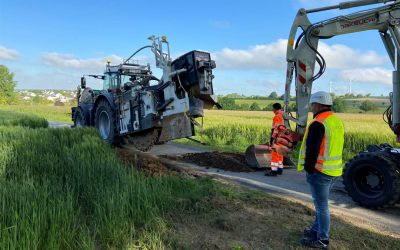Photo: IBZ Neubauer
When implementing broadband projects, different methods are used to lay the fiber optic cables. In contrast to “classic” civil engineering, in which an open trench is dug and the pipes are laid at least one meter deep, alternative laying techniques require less depth – and ideally almost no large excavation pit(s). Modern methods also save time and, not least, money.
In the fourth part of our “Alternative installation methods” series, we report on the ploughing method. In this traditional method, which has been specially adapted for laying fiber optic cables, a furrow is made in the ground using a laying plough, into which the empty conduit or fiber optic cable is laid. The furrow is then immediately sealed again.
The laying techniques for an area-wide fiber optic expansion play a special role for sparsely populated, mostly rural areas that are difficult to develop in order to provide citizens with a modern broadband connection and to advance the digital transformation of agricultural businesses and local companies. In many areas, the planned construction section consists of long distances between villages and often leads through rough terrain. In order to implement a fast and cost-effective expansion of the broadband infrastructure here too, the ploughing method offers an alternative laying technique to traditional civil engineering. The ploughing method has proven itself in rural areas in particular, as empty conduits and fiber optic cables can be laid in a wide variety of terrain over long overland stretches along roads, unpaved field and forest paths or even under agricultural land. Laying in stony ground (but not rock) is also no problem.
A major advantage of this method is that several pipes can be ploughed in at the same time. With the help of a laying plough, which is pulled by a tractor (usually a tractor) with a cable winch, empty pipes with an outer diameter of up to 250 millimetres and at a depth of 60 to 200 cm can be laid. The district of Fulda has already used this alternative laying technique to make rapid progress with broadband expansion locally. “The advantage of the ploughing method is that it can be laid quickly with comparatively little effort and little soil movement,” says Christof Erb, broadband coordinator for the district of Fulda – and emphasizes: “Especially in rural areas, this leads to faster success in the expansion project.” In contrast to the rather rare, above-ground laying of fiber optic cables, the ploughing method involves laying the empty conduits underground in the traditional way. A cable plow is used for this. This consists of a tractor to which a carrier for the so-called plough blade and a cable drum are attached. The soil is pushed aside by the plow, creating a furrow in the surface to lay an empty conduit. The drum with the conduits is usually mounted on the tractor in such a way that the cables can be laid evenly directly into the route created using an attachment. The trench is then backfilled with the excavated soil and compacted to restore the terrain.

Photo: IBZ Neubauer
Ploughing is relatively inexpensive and makes it possible to lay up to five kilometers of cable per day, for example in “open fields”. Additional surveying costs can be avoided, as measurements are taken during ploughing using GPS, allowing the fiber optic cable to be laid exactly along the pre-planned route. Another advantage is the minimal disruption to traffic, as the construction section can be quickly reopened to traffic.
Video: IBZ Neubauer
However, the plowing method is not possible in rocky soils. Here, for example, the flush drilling method is suitable, in which special drill heads are used and no open excavation is necessary. The ploughing method cannot be used on sealed surfaces such as roads either, meaning that the construction companies carrying out the work have to resort to traditional civil engineering or trenching, for example.
In order not to destroy existing infrastructure, precise knowledge of the surroundings is always necessary. For this reason, a check is made before every conduit is laid to determine whether there are any third-party cables or other infrastructure in the planned construction section. If cables are laid within agricultural areas, they must also be ploughed sufficiently deep to avoid damage caused by the ongoing cultivation of the fields.
Our “Alternative installation methods” series
DIN 18220 comes into effect – Alternative installation methods standardized
DIN 18220 comes into force on July 28. The full name of the standard is "DIN 18220:2023-08. Trenching, milling and ploughing methods for laying empty conduit infrastructures and fiber optic cables for telecommunications networks" and describes in detail the methods...
Classic and alternative installation methods
In order to enable the expansion of fiber optic networks throughout Germany, the players involved have a variety of installation methods at their disposal. The methods must be selected according to topological characteristics and special project requirements. Each...
Robots lay fiber optics in the sewer
An employee prepares the robot for use. Between 100 and 250 meters of fibre optic cable can be laid in this way per day. (Source: Fast Opti-com) Laying fiber optic cables in sewage pipes using robots is one of the alternative installation methods. These offer many...
Above-Ground Fibre Optic Installation – a Fast and Cost-Effective Alternative to Traditional Underground Construction
Photo: Adobe Stock When implementing broadband projects, different methods are used to lay the fibre optic cables. In contrast to "classic" civil engineering, in which an open trench is dug and the pipes are laid at least one meter deep, alternative laying techniques...
DIN 18220 comes into effect – Alternative installation methods standardized
DIN 18220 comes into force on July 28. The full name of the standard is "DIN 18220:2023-08. Trenching, milling and ploughing methods for laying empty conduit infrastructures and fiber optic cables for telecommunications networks" and describes in detail the methods...
Classic and alternative installation methods
In order to enable the expansion of fiber optic networks throughout Germany, the players involved have a variety of installation methods at their disposal. The methods must be selected according to topological characteristics and special project requirements. Each...
Robots lay fiber optics in the sewer
An employee prepares the robot for use. Between 100 and 250 meters of fibre optic cable can be laid in this way per day. (Source: Fast Opti-com) Laying fiber optic cables in sewage pipes using robots is one of the alternative installation methods. These offer many...
Above-Ground Fibre Optic Installation – a Fast and Cost-Effective Alternative to Traditional Underground Construction
Photo: Adobe Stock When implementing broadband projects, different methods are used to lay the fibre optic cables. In contrast to "classic" civil engineering, in which an open trench is dug and the pipes are laid at least one meter deep, alternative laying techniques...





